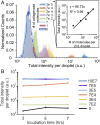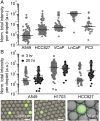Functional profiling of circulating tumor cells with an integrated vortex capture and single-cell protease activity assay
- PMID: 30224472
- PMCID: PMC6176626
- DOI: 10.1073/pnas.1803884115
Functional profiling of circulating tumor cells with an integrated vortex capture and single-cell protease activity assay
Abstract
Tumor cells are hypothesized to use proteolytic enzymes to facilitate invasion. Whether circulating tumor cells (CTCs) secrete these enzymes to aid metastasis is unknown. A quantitative and high-throughput approach to assay CTC secretion is needed to address this question. We developed an integrated microfluidic system that concentrates rare cancer cells >100,000-fold from 1 mL of whole blood into ∼50,000 2-nL drops composed of assay reagents within 15 min. The system isolates CTCs by size, exchanges fluid around CTCs to remove contaminants, introduces a matrix metalloprotease (MMP) substrate, and encapsulates CTCs into microdroplets. We found CTCs from prostate cancer patients possessed above baseline levels of MMP activity (1.7- to 200-fold). Activity of CTCs was generally higher than leukocytes from the same patient (average CTC/leukocyte MMP activity ratio, 2.6 ± 1.5). Higher MMP activity of CTCs suggests active proteolytic processes that may facilitate invasion or immune evasion and be relevant phenotypic biomarkers enabling companion diagnostics for anti-MMP therapies.
Keywords: cell secretion; circulating tumor cells; liquid biopsy; microfluidics; protease.
Conflict of interest statement
Conflict of interest statement: The Regents of the University of California have filed a patent for the integrated vortex capture and droplet generator device of which D.D.C. and M.D. are inventors.
Figures





References
-
- Cristofanilli M, et al. Circulating tumor cells: A novel prognostic factor for newly diagnosed metastatic breast cancer. J Clin Oncol. 2005;23:1420–1430. - PubMed
-
- Pierga J-Y, et al. Circulating tumor cell detection predicts early metastatic relapse after neoadjuvant chemotherapy in large operable and locally advanced breast cancer in a phase II randomized trial. Clin Cancer Res. 2008;14:7004–7010. - PubMed
-
- Danila DC, et al. Circulating tumor cell number and prognosis in progressive castration-resistant prostate cancer. Clin Cancer Res. 2007;13:7053–7058. - PubMed
-
- Alix-Panabières C, Pantel K. Clinical applications of circulating tumor cells and circulating tumor DNA as liquid biopsy. Cancer Discov. 2016;6:479–491. - PubMed
Publication types
MeSH terms
Substances
Grants and funding
LinkOut - more resources
Full Text Sources
Other Literature Sources

